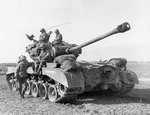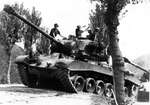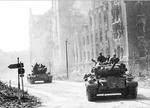M26 Pershing/M46
| Country | United States |
| Manufacturer | Detroit Tank Arsenal and Fisher Tank Arsenal |
| Primary Role | Heavy Tank |
Contributor: C. Peter Chen
ww2dbaseIn mid-1943, United States Army generals argued amongst themselves over the need for heavy tanks. Those who supported the effort introduced the T25 and T26 prototype tanks which were equipped with 90-millimeter guns and heavy armor plating. Production of these heavy tanks was delayed and did not start until Nov 1944 for a number of reasons, some of which political; for example, General Lesley McNair believed the best way to handle enemy tanks was to build a powerful force of lightly armored and mobile self-propelled guns, ie. tank destroyers, which were cheaper to build than tanks. They were first deployed to the front in Jan 1945, with US 3rd and 9th Armored Divisions receiving the first examples; the US 3rd Armored Division would be the first to put them in combat. In Mar 1945, these heavy tanks were redesignated M26 Pershing. By the end of the European War, 310 M26 Pershing tanks operated in Europe, but only 20 of them saw combat.
ww2dbaseOn 31 May 1945, a cargo ship transported 12 M26 Pershing heavy tanks from the United States to Okinawa, Japan, but by the time they arrived, there was already little need for their service. When they were completely unloaded at 4 Aug, fighting on Okinawa had already ended.
ww2dbaseIn May 1946, they were reclassified as M26 Pershing medium tank. 2,212 M26 Pershing tanks were built in 1944 and 1945.
ww2dbaseIn 1948, 800 M26 Pershing tanks received engine and transmission upgrades; these tanks were redesignated M26E2. In Jul 1948, these upgraded models were redesignated M26E2 Patton. In Nov 1949, the M26E2 Patton tanks were redesignated once again, this time simply M46. Before the end of the 1940s, an additional 360 M26 Pershing medium tanks would be converted to the M46A1 standard.
ww2dbaseIn Asia, both M26 Pershing and M46 medium tanks saw combat in the Korean War. In Europe, the US occupation forces in Germany continued to be equipped with M26 Pershing and M46 medium tanks until 1953. In 1952, several hundred M26 Pershing and M46 medium tanks were leased to Belgium, France, and Italy at no cost; some of those tanks would not become retired until 1969.
ww2dbaseSource: Wikipedia
Last Major Revision: Dec 2011
M26 Pershing/M46 Timeline
| 22 Dec 1944 | M26 Pershing heavy tanks were ordered to be deployed to forward US Army units. |
| 25 Feb 1945 | US 3rd Armored Division used M26 Pershing heavy tanks in combat for the first time near the Roer River in the Belgian-German border region. |
| 31 May 1945 | 12 M26 Pershing heavy tanks departed the United States board a cargo ship for Okinawa, Japan. They would arrive too late to see combat. |
| 21 Jul 1945 | 12 M26 Pershing heavy tanks arrived at Okinawa, Japan. |
| 30 Jul 1948 | The upgraded M26 Pershing medium tanks were redesignated M26E2 Patton (later again redesignated M46). |
SPECIFICATIONS
M26 Pershing
| Machinery | One Ford GAF 8-cyl gasoline engine rated at 450hp |
| Suspension | Torsion bar |
| Armament | 1x90mm M3 gun (70 rounds), 2x7.62mm Browning M1919 machine guns, 1x12.7mm Browning M2 machine gun |
| Crew | 5 |
| Length | 8.65 m |
| Width | 3.51 m |
| Height | 2.78 m |
| Weight | 41.7 t |
| Speed | 8 km/h off-road; 40 km/h on-road |
| Range | 160 km |
M46
| Machinery | One Continental AVDS-1790-5A 12-cyl air-cooled twin-turbo gasoline engine rated at 810hp |
| Suspension | Torsion bar |
| Armament | 1x90mm M3A1 gun (70 rounds), 2x7.62mm Browning M1919A4 machine guns, 1x12.7mm Browning M2 machine gun |
| Armor | 102mm maximum |
| Crew | 5 |
| Length | 8.48 m |
| Width | 3.51 m |
| Height | 3.18 m |
| Weight | 44.0 t |
| Speed | 48 km/h |
| Range | 130 km |
Photographs
 |  |  |  |
Please consider supporting us on Patreon. Even $1 per month will go a long way! Thank you. Please help us spread the word: Stay updated with WW2DB: |
Visitor Submitted Comments
12 Mar 2021 01:57:34 AM
Patton was unenthusiastic when planners suggested that the new M26 Pershing should be shipped immediately to the US First Army fighting in Normandy. He advised against deploying this 46-ton heavy because of the support it would require in terms of parts, fuel and shipping. It would be too big for the Class 40 Bailey Bridges and although its 90mm high velocity gun might be a terrific ‘Tank killer’ its armour protection was less than that found on the German Tiger or Panther tanks, and in the dense Normandy ‘Bocage’ terrain of small fields, sunken lanes, little villages and thick hedgerows, everywhere bristling with enemy machine guns, mortars and anti-tank guns, the M26 would be highly vulnerable and not easy to maintain or manoeuvre. The secret to winning in the hedgerows, he pointed out, was by developing new tactics and techniques, not in deploying monster tanks.
All visitor submitted comments are opinions of those making the submissions and do not reflect views of WW2DB.
- » US Government Plans to Purge WW2 Information (17 Mar 2025)
- » WW2DB's 20th Anniversary (29 Dec 2024)
- » Wreck of USS Edsall Found (14 Nov 2024)
- » See all news
- » 1,160 biographies
- » 337 events
- » 44,601 timeline entries
- » 1,243 ships
- » 350 aircraft models
- » 207 vehicle models
- » 376 weapon models
- » 123 historical documents
- » 261 facilities
- » 470 book reviews
- » 28,636 photos
- » 429 maps
Winston Churchill, on the RAF
Please consider supporting us on Patreon. Even $1 a month will go a long way. Thank you!
Or, please support us by purchasing some WW2DB merchandise at TeeSpring, Thank you!
1 May 2013 10:41:48 AM
I love this it has almost all the tanks and I'm doing reasrch over tanks it works like a charm